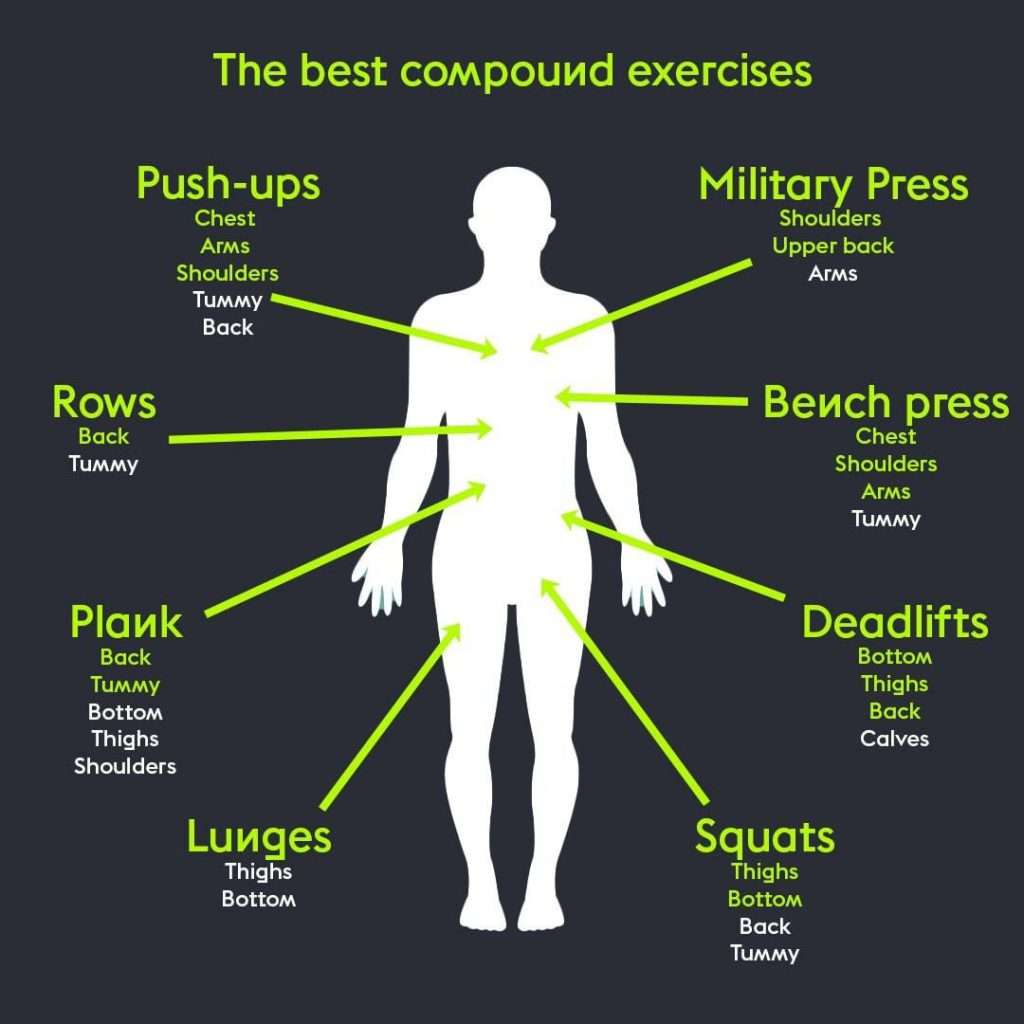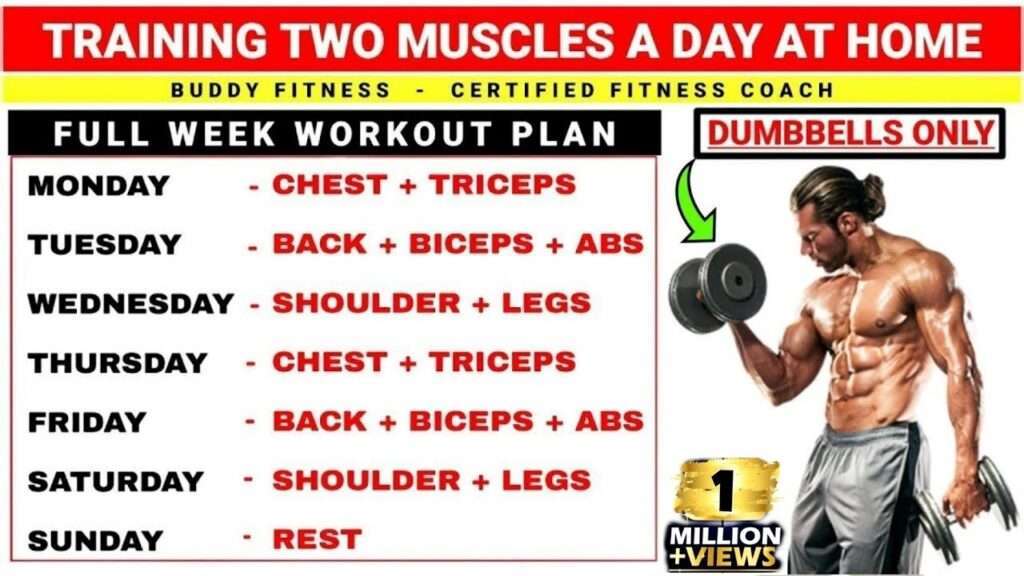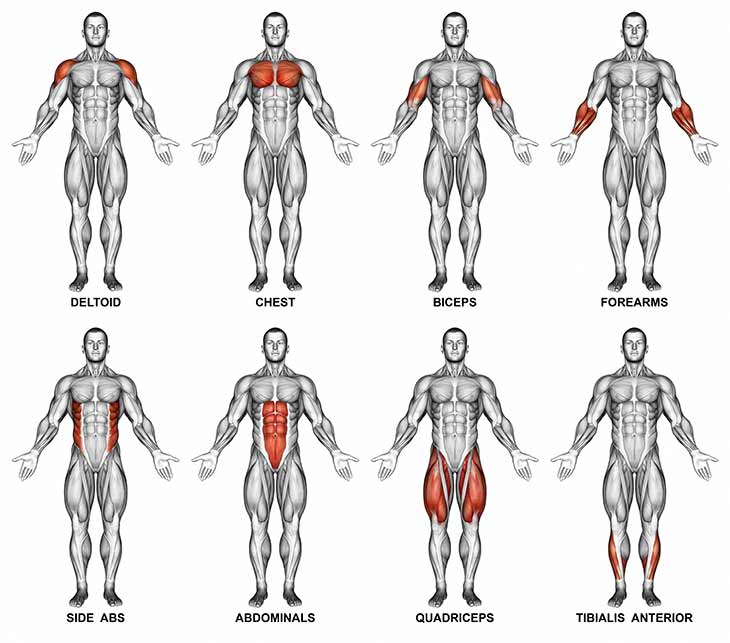When it comes to your fitness routine, one of the biggest questions is whether you should focus on working out different muscle groups every day. Should you dedicate each day to a specific area of your body or should you work out all muscle groups every day? This article explores the benefits and drawbacks of both approaches, shedding light on the most effective way to maximize muscle growth and overall strength. By the end, you’ll have a clearer idea of how to structure your workouts for optimal results.

Benefits of Working Out Different Muscle Groups Every Day
Increased muscle growth
When you work out different muscle groups every day, you give each muscle group the opportunity to be trained and stimulated more frequently. This can lead to increased muscle growth over time. By constantly challenging your muscles with different exercises, you promote muscle hypertrophy and create an optimal environment for muscle development.
Improved muscle recovery
By targeting different muscle groups each day, you allow for better muscle recovery. When you focus on one muscle group and give it a break the next day, you provide that muscle group with ample time to repair and rebuild. This promotes better recovery and reduces the risk of muscle fatigue and overtraining.
Enhanced muscle balance
working out different muscle groups every day helps to create a balanced physique. By targeting various muscle groups and avoiding excessive focus on a single group, you ensure that no muscles are neglected. This leads to improved muscle symmetry and overall aesthetic appeal.
Reduced risk of overuse injuries
When you work out different muscle groups every day, you avoid placing excessive stress on one specific area. This reduces the risk of overuse injuries which can occur from continuously working the same muscle group without allowing it sufficient rest and recovery time. By distributing the workload across multiple muscle groups, you minimize the strain on any particular area and promote overall joint and muscle health.
Drawbacks of Working Out Different Muscle Groups Every Day
Muscle fatigue and overtraining
While working out different muscle groups every day can lead to increased muscle growth, it can also lead to muscle fatigue and overtraining if not managed properly. Constantly exerting your muscles without adequate rest can result in decreased performance, increased risk of injury, and hindered muscle growth. It’s important to strike a balance between training intensity and proper recovery to avoid these drawbacks.
Limited time for muscle repair
If you consistently work out different muscle groups every day, you may limit the time available for muscles to repair and recover. While muscle growth relies on breaking down muscle fibers through exercise, it is during the recovery phase that muscles actually repair and grow stronger. It is vital to allow enough time for this repair process to occur to avoid muscle fatigue and potential injuries.
Increased risk of injury
Working out different muscle groups every day can also increase the risk of injury if you push yourself too hard or neglect proper form and technique. With minimal rest periods between muscle groups, there is a higher chance of overexertion and improper muscle activation. This can lead to strains, sprains, or even more serious injuries. It’s crucial to prioritize safety and listen to your body’s signals to avoid unnecessary harm.
Decreased exercise performance
If you constantly work out different muscle groups every day without giving them ample time to recover, you may experience a drop in exercise performance. Overtraining can lead to fatigue, decreased strength, and reduced stamina, which can negatively impact your workouts. It’s important to find the right balance between training frequency and recovery to maintain optimal performance levels.
Factors to Consider for Daily Muscle Group Workouts
Training experience and fitness level
Your training experience and fitness level play a crucial role in determining the most suitable approach to working out different muscle groups every day. Beginners may need more rest days and lighter training loads to avoid excessive strain, while advanced individuals can handle higher frequency and intensity. Tailor your workouts to your specific fitness level to avoid overtraining or underwhelming results.
Individual goals and preferences
Understanding your individual goals and preferences is key to choosing the most effective daily muscle group workout routine for you. If your goal is to build overall muscle mass, splitting muscle groups by days may be beneficial. On the other hand, if time is limited, full body workouts or active recovery days can be better options. Consider what you enjoy and what will help you achieve your desired results.
Recovery abilities
Everyone’s recovery abilities vary, so it’s important to assess your own ability to recover before committing to daily muscle group workouts. If you find that you recover quickly and experience minimal muscle soreness, you may be able to handle higher training frequency. However, if you struggle with recovery or feel excessively sore, it may be better to incorporate more rest days or adjust the intensity and volume of your workouts.
Training program design
The design of your training program is crucial when it comes to daily muscle group workouts. A well-structured program should include a balance of exercise variety, progressive overload, and proper rest periods. It should incorporate exercises that target different muscle groups and allow for sufficient recovery time. A carefully designed program will help maximize the benefits of daily muscle group workouts while minimizing the risk of overtraining and injury.
Alternatives to Working Out Different Muscle Groups Every Day
Splitting muscle groups by days
Instead of working out different muscle groups every day, you can split your workouts by specific muscle groups on different days of the week. For example, you may dedicate one day to working your chest and triceps, another day for back and biceps, and so on. This approach allows for more targeted training and increased recovery time for each muscle group.
Full body workouts
If time is a constraint, full body workouts can be a great alternative to daily muscle group workouts. By performing compound exercises that engage multiple muscle groups in a single session, you can still achieve overall muscle development. Full body workouts are efficient and can stimulate muscle growth while providing sufficient rest periods for each muscle group.
Active recovery days
Incorporating active recovery days into your workout routine can be beneficial for overall muscle health and performance. On these days, you engage in low-intensity activities such as yoga, stretching, or light cardio to promote blood flow, alleviate muscle soreness, and enhance recovery. Active recovery allows your muscles to recover while still remaining active and mobile.

Implementing Daily Muscle Group Workouts Safely
Proper warm-up and cool-down
To minimize the risk of injury and optimize performance during daily muscle group workouts, it is crucial to incorporate proper warm-up and cool-down routines. Warm-ups should include dynamic stretching, mobility exercises, and light cardio to prepare your muscles and joints for the upcoming workout. Cool-downs should consist of static stretching and gentle movements to help your body recover and reduce post-workout soreness.
Using correct form and technique
One of the most important aspects of any workout is maintaining correct form and technique. When working out different muscle groups every day, it is essential to prioritize proper form to minimize the risk of injury and ensure effective muscle activation. If you are unsure about the correct technique for a particular exercise, consider working with a qualified fitness professional to guide you.
Gradual progression and periodization
To prevent overtraining and achieve optimal results, it’s important to implement gradual progression and periodization in your daily muscle group workouts. Gradually increasing the intensity, volume, or complexity of your exercises over time allows your muscles to adapt and grow stronger. Periodization involves incorporating varying levels of intensity and volume throughout different phases of your training program, ensuring that your body experiences different stimuli and avoids plateaus.
Listening to your body’s signals
Your body is the best indicator of when it’s time to rest, recover, or adjust your training. Pay attention to any signs of fatigue, pain, or extreme muscle soreness. If you feel excessively tired or experience persistent pain, it may be a signal that you need to take a rest day or modify your workout routine. Ignoring your body’s signals can lead to overtraining and potential injuries.
Designing an Effective Daily Muscle Group Workout Routine
Muscle group selection
When designing a daily muscle group workout routine, it is important to consider the selection of muscle groups you will target each day. Aim to distribute the workload evenly across major muscle groups to promote balanced muscle development and prevent overuse injuries. You may consider alternating between upper body and lower body, or focusing on specific muscle groups such as legs, chest, back, or shoulders.
Exercise variety
Incorporating a variety of exercises in your daily muscle group workouts is key to maximizing results. By using different exercises that target the same muscle group, you ensure that all muscle fibers are properly stimulated. This prevents plateauing and promotes continuous muscle growth. Additionally, exercise variety keeps your workouts interesting and helps prevent boredom.
Training frequency and volume
Determining the appropriate training frequency and volume for your daily muscle group workouts is essential to avoid overtraining and achieve optimal results. Consider factors such as your fitness level, recovery abilities, and overall training goals. Beginners may start with a lower frequency and gradually increase it over time, while more advanced individuals may be able to handle higher training volumes. Finding the right balance is important to prevent burnout and injury.
Rest and recovery strategies
While daily muscle group workouts can be effective, it is crucial to incorporate rest and recovery strategies into your routine. Rest days allow your muscles to repair, recover, and grow stronger. Consider scheduling at least one or two rest days per week and listen to your body’s signals for additional rest if needed. You can also incorporate active recovery, stretching, and foam rolling techniques to enhance muscle recovery and reduce muscle soreness.

Tips for Maximizing Results with Daily Muscle Group Workouts
Prioritize compound exercises
Include compound exercises in your daily muscle group workouts to maximize results. Compound exercises, such as squats, deadlifts, and bench presses, engage multiple muscle groups simultaneously, leading to more efficient and effective workouts. These exercises also promote increased muscle activation and stimulate the release of growth hormones, facilitating muscle growth and strength development.
Incorporate rest-pause or drop sets
To challenge your muscles and promote muscle growth, consider incorporating rest-pause or drop sets into your daily muscle group workouts. These techniques involve performing multiple sets with short rests or decreasing weight between sets, respectively. By pushing your muscles to fatigue in a controlled manner, you stimulate muscle fibers and promote muscle hypertrophy.
Vary rep ranges and intensity
Changing the rep ranges and intensity of your exercises can help prevent plateaus and optimize muscle growth. Incorporate both low-intensity, high-repetition sets as well as high-intensity, low-repetition sets into your routine. This variation targets different muscle fibers and challenges your muscles in different ways, leading to greater overall development.
Focus on proper nutrition and hydration
To support muscle growth and recovery, it is crucial to focus on proper nutrition and hydration. Ensure you consume adequate protein to provide your muscles with the necessary building blocks for repair and growth. Hydration is also key to maintaining optimal muscle function and preventing muscle cramps or fatigue during workouts. Aim to consume a balanced diet and stay hydrated throughout the day.
Sample Daily Muscle Group Workout Splits
Upper body/lower body split
Day 1: Upper Body
- Chest exercises (e.g., bench press, push-ups)
- Back exercises (e.g., rows, pull-ups)
- Shoulder exercises (e.g., overhead press, lateral raises)
- Arm exercises (e.g., bicep curls, tricep dips)
Day 2: Lower Body
- Leg exercises (e.g., squats, lunges)
- Hamstring exercises (e.g., deadlifts, hamstring curls)
- Calf exercises (e.g., calf raises)
- Core exercises (e.g., planks, Russian twists)
Push/pull/legs split
Day 1: Push (Chest, Shoulders, Triceps)
- Chest exercises (e.g., bench press, chest flyes)
- Shoulder exercises (e.g., military press, front raises)
- Tricep exercises (e.g., tricep pushdowns, dips)
Day 2: Pull (Back, Biceps, Abs)
- Back exercises (e.g., rows, pull-ups)
- Bicep exercises (e.g., bicep curls, hammer curls)
- Abdominal exercises (e.g., crunches, hanging leg raises)
Day 3: Legs (Quads, Hamstrings, Calves)
- Quadricep exercises (e.g., squats, leg extensions)
- Hamstring exercises (e.g., deadlifts, hamstring curls)
- Calf exercises (e.g., calf raises)
Chest and triceps/Back and biceps split
Day 1: Chest and Triceps
- Chest exercises (e.g., bench press, dumbbell chest press)
- Tricep exercises (e.g., tricep dips, tricep pushdowns)
Day 2: Back and Biceps
- Back exercises (e.g., rows, pull-ups)
- Bicep exercises (e.g., bicep curls, hammer curls)
Quad dominant/Hamstring dominant split
Day 1: Quad Dominant (Quadriceps, Glutes)
- Quadricep exercises (e.g., squats, lunges)
- Glute exercises (e.g., hip thrusts, glute bridges)
Day 2: Hamstring Dominant (Hamstrings, Calves)
- Hamstring exercises (e.g., deadlifts, hamstring curls)
- Calf exercises (e.g., calf raises)

Common Mistakes to Avoid with Daily Muscle Group Workouts
Neglecting proper warm-up and cool-down
Skipping warm-up routines before your daily muscle group workouts can increase the risk of injury. It’s important to prepare your muscles and joints for exercise by incorporating dynamic stretching and light cardio. Similarly, neglecting the cool-down phase can lead to increased muscle soreness and delayed recovery. Take the time to cool down properly by including static stretching and gentle movements.
Neglecting rest and recovery
In the pursuit of achieving results, it can be tempting to push yourself to work out every day. However, neglecting rest and recovery can be detrimental to your progress. Remember that muscles grow and become stronger during the recovery phase, so it’s important to incorporate rest days into your routine. Overtraining can lead to burnout, decreased performance, and increased risk of injury.
Overtraining specific muscle groups
While it’s important to challenge and stimulate your muscles, overtraining specific muscle groups by working them excessively can lead to imbalances and increased risk of injury. Each muscle group needs sufficient rest and recovery time to avoid strain and allow for proper growth. Ensure that you distribute your training load evenly across different muscle groups to maintain a balanced physique.
Ignoring form and technique
Performing exercises with incorrect form and technique can significantly increase the risk of injury. This is especially important when working out different muscle groups every day, as each muscle group requires proper activation and control. Take the time to learn and practice the correct form for each exercise. If you’re unsure, consult a fitness professional for guidance.
Conclusion
Working out different muscle groups every day presents both benefits and drawbacks. It can lead to increased muscle growth, improved muscle recovery, enhanced muscle balance, and reduced risk of overuse injuries. However, there are potential drawbacks such as muscle fatigue, limited time for muscle repair, increased risk of injury, and decreased exercise performance.
When considering daily muscle group workouts, it is important to take into account factors such as training experience, individual goals, recovery abilities, and training program design. Alternatives include splitting muscle groups by days, opting for full body workouts, or incorporating active recovery days.
To implement daily muscle group workouts safely, prioritize proper warm-up and cool-down, use correct form and technique, incorporate gradual progression and periodization, and listen to your body’s signals. Design an effective workout routine by selecting appropriate muscle groups, varying exercises, managing training frequency and volume, and including rest and recovery strategies.
Maximize your results with daily muscle group workouts by prioritizing compound exercises, incorporating rest-pause or drop sets, varying rep ranges and intensity, and focusing on proper nutrition and hydration.
Remember to balance your workouts, avoid common mistakes such as neglecting warm-up and cool-down or rest and recovery, and pay close attention to maintaining proper form and technique. Whether you choose to work out different muscle groups every day or adopt alternative approaches, your individual goals and preferences should guide your decisions.

